When you’re on the road, you can feel more like a juggler than a traveler: You’ve got your notebook, your smart phone, your camera, your GPS device, your MP3 player — and all the power cords, USB drives and other gadgets that go with them.
And you still have to deal with some of travel’s biggest annoyances: dropped cell phone calls in hotel rooms, faint Wi-Fi signals in airports, data files that vanish without a trace and power-sucking gadgets that invariably go dead just when you need them most.
Overwhelmed? Take heart – adding a few key gadgets to your arsenal could help. The eight handy devices and services detailed below can help you charge, connect, boost and protect your array of mobile devices and the data they contain. With some of these you might find yourself carrying fewer cables, chargers and other travel detritus.
You may not want or need to carry all the gizmos discussed here – after all, when you’re on the road, less is more. Smart road warriors will assess their own needs and zero in on the most useful tools for them.
Charge it
“Simplify, simplify,” said Thoreau. He was probably talking about the chargers that come with every gadget you carry.
There’s no law that says you have to carry a different charger for each device or that it has to connect to 110-volt AC. In fact, as more gadgets require USB connections to sync data or download software, your laptop is becoming a universal charger.
The only problem? Most laptops require 110-volt AC to charge themselves – and have a limited number of USB ports for charging your other devices.
The ideal solution would be one charger that could draw power from as many different sources as possible and charge as many different devices as you carry. The ideal charger hasn’t been manufactured yet, but there are a couple that come close:
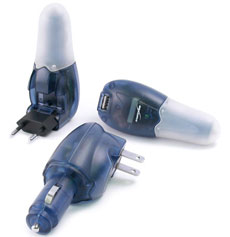
The VersaCharger Pro, available with European or U.S. AC plugs
VersaCharger Pro
The VersaCharger Pro from BoxWave Corp. connects to three power sources. It’s available with a flip-out U.S. or European-style AC plug (your choice) for 110 and 220 volts, a car cigarette-lighter connector and an optional short cable to convert the car connector to those small round airplane-seat power outlets that are supposed to be standard, but the airlines won’t say when.
Output is a standard USB connector, so if your devices connect to and charge from Universal Serial Bus, you’ve already got the cable you need. If they don’t, BoxWave also sells a miniSync cable with the proper connector. The VersaCharger Pro with airplane charger is $35.20, and extra miniSync cables, if you need them, start at $14.95. Shipping, as you might expect, is extra.
iGo everywhere85
While the VersaCharger’s 1-amp, 5.3-volt output is more than adequate to charge handheld devices, it won’t do for laptops. For that, you need the iGo everywhere85 notebook power adapter from Mobility Electronics.
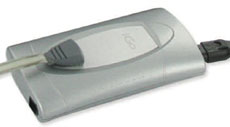
The iGo everywhere85
This small (4.8 by 2.7 by 0.9 in.), light (8 oz.) power brick is also a three-way device for AC/car/plane. It comes with the cables you need, including a neat retractable laptop connector cable, and a standard set of interchangeable connector tips.
Alas, simplicity isn’t always simple to achieve: You’ll have to use iGo’s Solution Finder tool to determine whether your notebook can use the everywhere85 (70 watts continuous/85 watts peak output, $129.99) or need the slightly larger (6.1 by 2.5 by 1.3 in.), heavier (17 oz.) everywhere130 (90 watts continuous/130 watts peak, $149.99).
And make sure you’re getting all the necessary cables and connectors. If none of the standard connector tips fits your laptop, you’ll also have to lay out for one of those — they run $9.99 and up. (Sadly, but not unexpectedly, there are no connectors for Apple MacBooks.)
Neat feature: Both models of the iGo everywhere charger also let you charge a handheld simultaneously with the laptop — but you have to buy a separate connector tip.
Connect it
How many times a day does this happen to you? You sit down, open up your laptop and check for an available wireless connection. And you discover once again that the few that aren’t locked down aren’t free.
You could buy yet another day pass or subscribe to yet another chain’s service. But what you really need is some one-stop shopping: a wireless connection account that gives you access to more than one set of hot spots.
iPassConnect
Enter iPass. In March, iPass Inc. began selling its iPassConnect Wi-Fi connectivity service, which was formerly available to only enterprise customers, directly to individuals.
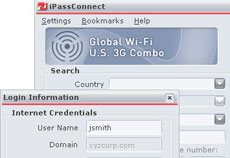
Logging into iPassConnect
For $29.95 a month, you can get unlimited access to more than 24,000 Wi-Fi hot spots and Ethernet-equipped hotels in the U.S. — brand-name places that include Starbucks, Borders, McDonald’s, Hilton, Sheraton, Radisson, Hyatt and a gaggle of airline clubs and airport sites.
If you travel overseas, $44.95 will get you access in more than 90,000 Wi-Fi hot-spot and Ethernet locations, as well as local dial-up numbers, in 160 countries. And if you go beyond the reach of wireless LANs, $69.95 (plus a $125 service fee) will get you a 3G WAN card and access to 1xRTT or EV-DO mobile broadband in most of urban and suburban America. And $84.95 will take those capabilities overseas.
This is all integrated via the iPassConnect Mobility Manager, a single application that identifies and connects to Wi-Fi hot spots (including your home router if you have one), WAN, wired Ethernet in hotels or dial-up phone lines (the directory is built into the software).
Boost it
Why is it that no matter where you travel, you always get stuck in Bermuda Triangle wireless locations — the remote seat in the airport lounge where Wi-Fi signals are only a rumor, or the hotel room where you have to stand on the windowsill to get a mobile phone signal?
Well, don’t worry — you can fight back.
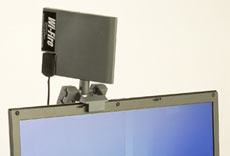
The Wi-Fire attached to a laptop
Wi-Fire
The Wi-Fire long-range Wi-Fi adapter from hField Technologies Inc. combines a range-boosting directional antenna, a sensitive receiver and proprietary software to pull in wireless LAN signals at triple or more the range of standard Wi-Fi adapters.
The Wi-Fire adapter is a minuscule 4-ounce device that you can slip into your laptop bag and forget about until you need it. It works on 802.11b/g signals and connects via a USB port to a Windows PC (the software works with XP or Vista) or a Mac (OS X, including Leopard). You can order the Wi-Fire for $79 directly from hField’s Web site.
zBoost Personal
If your problem is getting a cell phone signal, then you need the zBoost Personal cell phone signal booster. This is a portable version of a similar product that solves cell-phone reception problems in homes and offices by installing an antenna outside the house and a signal-amplifying repeater indoors.
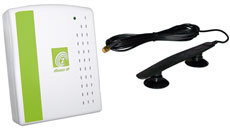
The zBoost Personal
The Personal version covers a smaller area than its big brother, but it carries a lower price tag ($169) and comes in a package small enough to fit into your travel kit (4 by 5 by 1.3 in.). The dual-band (800/1,900-MHz) device comes with an external antenna that can attach to the nearest window with suction cups.
Plug it into an AC outlet, and it creates a four- to six-foot bubble of good reception where you want it.
Protect it
One of the most important things about taking your digital devices on the road is making sure you get home with them. There are lots of ways to increase the likelihood of recovering your iPod or smart phone or laptop if it walks away: some very low-tech, others higher.
Cellophane tape, for example: Tape a slip of paper with your name and identifying information (e-mail address, cell phone number) in an inconspicuous place on the device – inside the battery cover or the backside of the battery itself.
Then mark it conspicuously as well – for example, if you can bring yourself to do it, stick your next few “Hi! My name is …” badges to the lid of your laptop. If it says it’s yours, it’s a lot less likely to wind up in somebody else’s hands by mistake.
If it does get away from you, all may not yet be lost.
Computrace LoJack for Laptops
Computrace LoJack for Laptops maker Absolute Software Corp. claims that it recovers three out of four stolen computers that are loaded with its software. Once you install the application, the laptop silently contacts the company’s monitoring center whenever it’s online.
If you report the laptop stolen, the company’s recovery team begins tracking the computer, using information the laptop provides to identify its location. It then gives law enforcement the tracking information and documentation needed for search warrants.
At $49.99 for a year of coverage, or three years for $99.99, it’s inexpensive for peace of mind.
LoJack for Laptops is available for Windows XP, Vista and Mac OS X 10.3 and up, and you can order it online. (Both Safari and Firefox for Mac work with the Web site. On a PC, you need Internet Explorer 6.0 or later.)
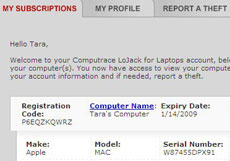
LoJack for Laptops
GadgetTrak
If you don’t like the idea of a monitoring center tracking your computer’s movements, WestinTech Ltd.’s GadgetTrak works similarly to LoJack for Laptops but sends the information it collects directly to you via e-mail. If your system is stolen, you can contact police with the location information gathered by the software.
The Windows version (for NT/2000/2003/XP/Vista) costs $39.95 for a one-year subscription, or $69.95 for three years. The Mac version (requires OS X 10.4 or higher) uses the computer’s built-in iSight camera to capture video of whoever has your computer; it comes with a one-time price tag of $39.95.
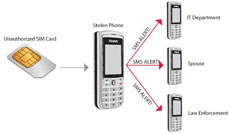
GadgetTrak can trace stolen cell phones
GadgetTrak also offers theft-recovery services for GSM cell phones for a one-time fee of $24.95 per device. It supports BlackBerry, Windows Mobile and Symbian users. There’s also a GadgetTrak service for USB-connected media devices such as MP3 players, digital cameras and flash drives. Prices range from $12.95 per year for a single device to $64.95 for 20 devices.
(Another good option for tracking your removable media devices is the new ihound service from ihound Software LLC. During its alpha/beta phase, users can track up to three USB-connected devices for free, but the software currently works only with PCs running Windows 2000, XP or Vista.)
Of course, you don’t have to lose your computer to lose your computer. A disk crash or similar accident can wipe out all your data, a whole trip’s worth of work. And then there are those all-too-human errors where you know you saved the file, but you don’t know where. Data backup may be most important when it’s least available, when you’re on the road and on the run.
But if you’ve got Web access, you’ve got backup. It can be really simple, like e-mailing yourself the documents you create — especially good if you use a Web-based mail service such as Google Inc.’s Gmail. If you work with bigger files or want a more all-encompassing backup, try one of the Web-based backup services.
MozyHome
EMC Corp.’s MozyHome service gets high marks for its features and interface, and better still, you can create a personal account that gives you 2GB of free backup space — plenty to safeguard what you do while you’re traveling.
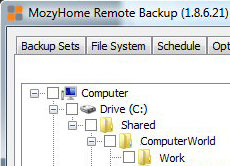
MozyHome remote backup
The company is obviously hoping you’ll like the service enough to sign up for its $4.95-per-month unlimited plan, which really does offer unlimited storage space but not (a word to the wise) unlimited bandwidth — a full backup of a large laptop drive can take days.
Like most backup applications, Mozy requires a learning curve, so give yourself time to install the MozyHome application and figure out the “expert wizard” and the difference between Mozy’s “backup sets” and the file-and-folders structure you’re used to working with on your hard drive. There is a manual (download PDF), though it’s sort of a well-kept secret. MozyHome works with Windows 2000, XP and Vista as well as Mac OS X 10.4 and later.
Go for it
There you have it: eight great tools for keeping you charged, connected, boosted and protected. Choose the ones that will help you the most, and you’re good to go, road warrior.
Source: Computerworld.com




